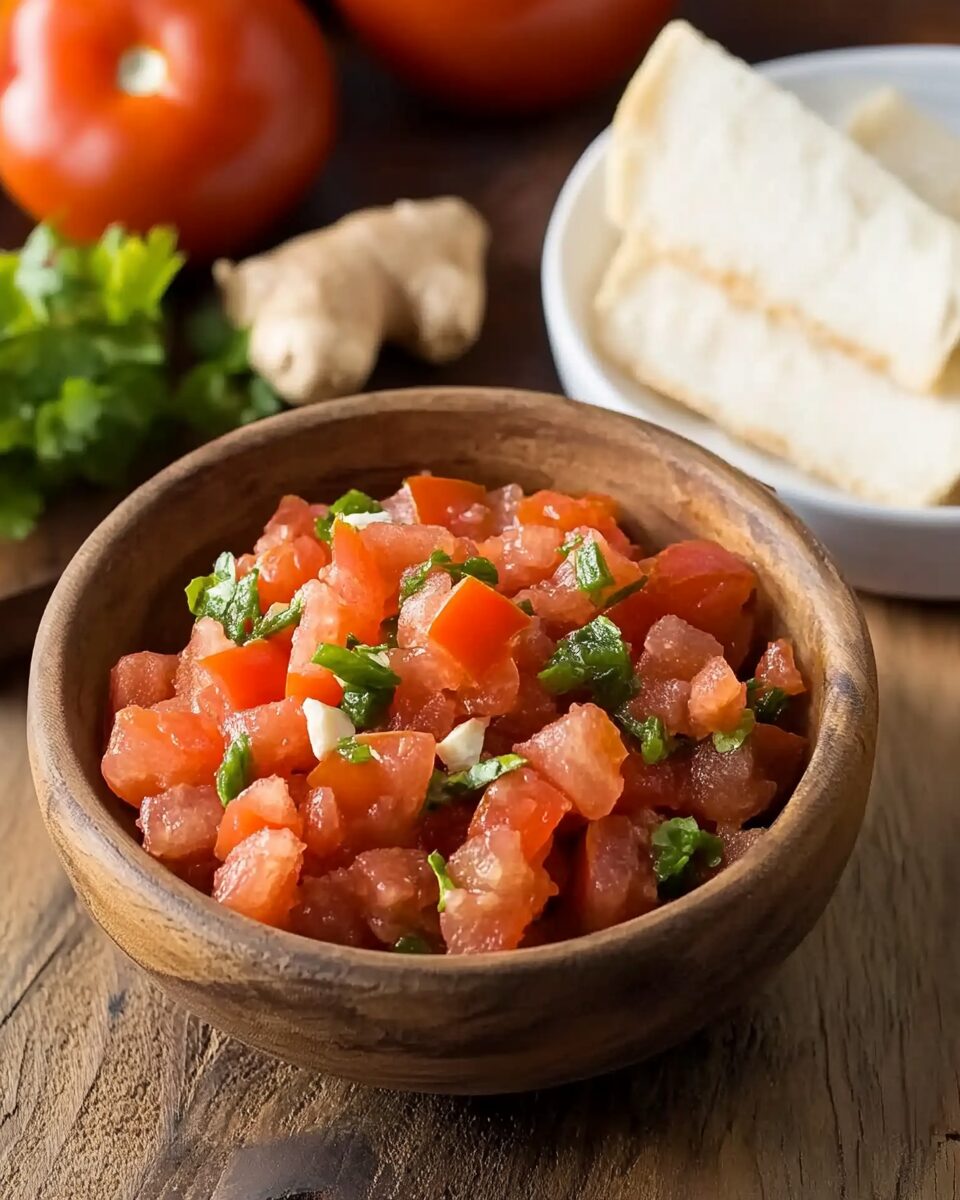Why This Recipe Works
This relish is a showcase of ingredient-driven cooking at its best. There’s no cooking involved, no complicated technique—just fresh, quality ingredients chopped and combined in perfect balance. Here’s why it works so well:
-
Ripe tomatoes provide a juicy, sweet-tart base and are the soul of the dish.
-
Scallions add a mild oniony bite and aromatic depth without overpowering the freshness.
-
Lime juice brightens the flavor profile and acts as a natural preservative.
-
Fresh ginger introduces subtle heat and warmth, making the relish more complex and aromatic.
-
Kosher salt enhances every ingredient and helps draw out the natural juices.
-
Fresh cilantro or parsley rounds it out with a fragrant, herbaceous lift.
Letting the mixture rest before serving is key—the 20–120 minutes of marination allows the lime and salt to soften the tomatoes and meld the flavors. The result is vibrant, juicy, and nuanced, yet clean and refreshing.
Flavor and Texture Highlights
Lasary Legioma is all about contrasts:
-
Juicy and fresh from the tomatoes
-
Crunchy and aromatic from the scallions
-
Tangy and zingy from the lime and ginger
-
Lightly salted to balance and highlight sweetness
-
Herby and fragrant from cilantro or parsley
Unlike some cooked relishes or chutneys, Lasary Legioma retains its raw, crisp texture, giving it versatility as both a topping and a side salad. It’s refreshing without being watery, and bright without being overly acidic, making it ideal for cutting through rich meats or creamy cheeses.
Cultural Origins and Culinary Context
In Malagasy cuisine, lasary refers broadly to a variety of vegetable relishes or salads that accompany rice, the staple of most meals. There are countless variations of lasary across Madagascar—some made with cabbage or green beans, others with mango, carrots, or pickled ingredients.
Lasary Legioma is a tomato-based variant, more typical in coastal or urban regions where fresh produce is widely available. It reflects the influence of both African and Southeast Asian ingredients, using elements like lime, ginger, and herbs commonly found in tropical cuisines.
Often served as a side or condiment, it’s part of a balanced table of small dishes (laoka), which can include curries, stir-fried vegetables, grilled proteins, and stews. Lasary brings brightness and acidity to meals that might otherwise be heavy or richly spiced.
Nutritional Highlights
Lasary Legioma is a nutrient-rich and low-calorie dish, making it an excellent option for health-conscious eaters:
Per serving (out of 6 servings):
-
Calories: 24
-
Fat: 0g
-
Saturated Fat: 0g
-
Cholesterol: 0mg
-
Sodium: 112mg
-
Carbohydrates: 5g
-
Dietary Fiber: 2g
-
Sugars: 3g
-
Protein: 1g
-
Vitamin C: 18mg (92% DV)
-
Potassium: 271mg (6% DV)
It’s naturally vegan, gluten-free, dairy-free, and low in calories, while still being incredibly satisfying thanks to the combination of fiber, water content, and bold flavor.
Tips for Best Results
-
Use ripe, firm tomatoes. Roma or plum tomatoes work best because they’re less watery, but any high-quality tomato will do.
-
Chop finely to create a spoonable texture that spreads easily and melds with other components on the plate.
-
Fresh lime juice is essential. Bottled versions lack the brightness and complexity of fresh juice.
-
Minced ginger should be fresh, not powdered—raw ginger brings brightness, heat, and a zingy punch that dried cannot replicate.
-
Rest before serving. A 20-minute marination softens the tomato texture and balances the sharpness of lime and ginger.
-
Adjust seasoning after resting. The salt and lime will evolve over time—taste again before serving.
Serving Suggestions
Lasary Legioma is highly versatile and can be served in many ways:
Traditional Malagasy serving ideas:
-
As a side with steamed white rice and laoka (like fish stew or stir-fried greens)
-
With grilled meats, especially chicken or pork
-
Alongside smoked or grilled fish for contrast
Modern pairings:
-
As a bruschetta topping on crusty bread or toast
-
Spoon over grilled halloumi, goat cheese, or ricotta toast
-
With tortilla chips or plantain chips as a dip
-
Over grain bowls (quinoa, farro, couscous) with avocado or tahini drizzle
-
Inside wraps or sandwiches for a fresh, tangy layer
-
Paired with omelets, scrambled tofu, or fried eggs
It’s a perfect condiment for both warm and cold dishes, making it ideal for meal prep, brunches, and potlucks.
Make-Ahead and Storage Tips
-
Lasary Legioma can be made ahead and stored in the fridge for up to 3 days.
-
The flavor improves over the first day but may lose some crunch.
-
Store in an airtight container and bring to room temperature before serving for best flavor.
-
If excess juice accumulates, gently stir or strain slightly before using.
-
Add fresh herbs just before serving if you want a brighter, more fragrant finish.
Why You’ll Love This Recipe
Lasary Legioma is an easy, no-cook dish that brings freshness, tang, and texture to everything it touches. It’s a delicious way to use up ripe tomatoes, and with just a handful of pantry and garden ingredients, you can whip it up in minutes. It’s light enough for summer, flavorful enough for winter, and versatile enough for every season in between.
This relish invites you to explore a lesser-known corner of African island cuisine while providing all the convenience of a 20-minute prep and no heat required. It’s a refreshing, healthy addition to any meal—and it just might become your new go-to condiment.
Conclusion
Lasary Legioma is a bright, beautiful tomato relish that captures the soul of Malagasy cooking—simple, seasonal, and packed with flavor. With its clean ingredients, quick prep, and endless pairing options, it’s the kind of dish that brings joy to the table with minimal effort. Whether served alongside traditional laoka or spooned over toast, it offers a taste of Madagascar’s tropical freshness in every bite. Try it once, and you’ll find yourself making it again and again.






